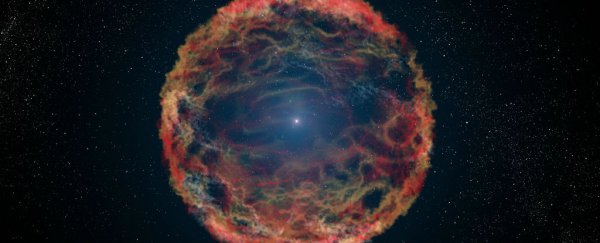A couple of weeks ago, researchers discovered radioactive debris from a series of massive supernova explosions at the bottom of our largest oceans, dating back to between 3.2 and 1.7 million years ago. That in itself was pretty shocking, but we now have new evidence that chunks of detonated stars are still raining down on Earth to this day.
Thanks to observations made by NASA's ACE spacecraft, scientists now suspect that when a star exploded relatively close to Earth, it left behind a rare type of radioactive metal called iron-60. Then a second star exploded, and accelerated all this debris to near-light speed. Turns out, it's been raining down onto our planet ever since.
Just like on Earth, everything in space must die, including the massive balls of fire we call stars. When a star dies, it goes out with a bang - the biggest explosion in the known Universe - and that bang is called a supernova.
There are two types of supernova: one occurs when a binary system of stars cannibalises itself, with one star stealing so much matter from its companion, it explodes; and the other occurs at the end of a single star's lifetime.
So one is an incredibly creepy, 7even-style death, and the other is basically a star's version of dying peacefully in bed (but with more explosions).
The 'dying peacefully in bed' version gets underway when a star becomes so old, and its core gets so heavy, it collapses in on itself.
"As the star runs out of nuclear fuel, some of its mass flows into its core. Eventually, the core is so heavy that it cannot withstand its own gravitational force," NASA explains, adding that our Sun might be a single star, but it doesn't have enough mass to become a supernova. So… high fives?
Iron-60 from exploding stars has been found deep down in the crusts of Earth, below the ocean floor, and also on the surface of the Moon. And thanks to iron-60's half-life of 2.6 million years, scientists have narrowed down the time of its arrival to between 3.2 and 1.7 million years ago.
But new evidence suggests that iron-60 isn't done bombarding Earth. A new paper published in Science today describes how NASA's Ace spacecraft has detected iron-60 floating around in space over the past 17 years, which means 'new' pieces are still finding their way to our neighbourhood.
In other words, we've just caught these radioactive bits of metal in the act, rather than millions of years after they'd hit us.
"It all fits together very nicely," one of the authors of the Science paper, physicist Martin Israel from Washington University, told Loren Grush at The Verge. "It's all consistent."
According to Grush, the ACE spacecraft has been encountering iron-60 at a rate of about one nucleus per year. Yep you heard that right - one nucleus per year. Which gives you an idea of how not freaked out you should be about this.
But a lot can be learned from those single nuclei - Israel and his team were able to confirm that their origin lies with recent, nearby supernovae. "The fact that we're seeing iron-60 at all means the cosmic rays must have been accelerated not terribly long ago," Israel told Grush.
It's thought that these stars died in the nearby Scorpius-Centaurus Association star cluster, located more than 380 light-years from Earth.
"Although these iron-60 particles have a different origin, all new detections point to the same scenario," Anton Wallner, a physicist at Australian National University and author of one of the recent Nature papers, told The Verge. "They all agree with the scenario of several supernova explosions in the last few million year nearby Earth."
So while we don't have much to worry about here - unless these constant bombardments start messing with our climate - it's a good little reminder that, while we might feel safe and snug on our perfectly habitable home planet, we belong to a bustling cosmic neighbourhood, and sometimes, weird shit's gonna end up in our backyard.
